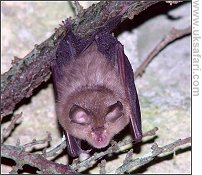
|

|
|
 Sent
to you Sent
to you
by e-mail
|
|
Simply
enter your details and hit the send button
more
info |
|


Click Here

Links
Advertise
Terms of Use
Contributors
About Us
Contact Us
|
 |
Go back
 | Bookmark
| Bookmark
 | Print Page
| Print Page  | E-Mail Us
| E-Mail Us 



Photo: Janice Whittington
|
|
UK
Safari Tip:
Find out all about bats with this fully illustrated fold out identification chart - click
here
|
|
See larger image
Latin name: Rhinolophus hipposideros
Size: Wingspan approximately 19 to 25cm.
Distribution: Rare. Found mainly in Wales and south west England.
Months seen: April to October
Food: Insects (moths, beetles, craneflies).
Habitat: Old buildings and caves
Echolocation Frequency: 105 - 115 kHz
Special features: Lesser Horseshoe bats get their name from the horseshoe-shaped flap of skin around their nose. This flap is used as a part of their echolocation system - a bit like a satellite dish focusing sound waves. They have a head and body length of around 4cm.
Lesser Horseshoe bats emerge from their roosts between 30 and sixty minutes after sunset.
 Photo of a lesser horseshoe being measured by an ecologist. Gloves are always worn by bat workers when handling bats for safety. Photo of a lesser horseshoe being measured by an ecologist. Gloves are always worn by bat workers when handling bats for safety.

Bat Identification Charts
Bat Calls on CD - Learn to Identify Different Species
Bat Detectors
UK Safari Bat Section
What is a bat?
What is Echolocation?
What does a bat sound like?
What is a tragus?
Links to Bat Groups in Britain
|
 |

|